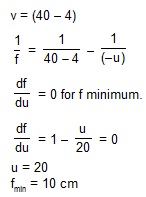1. A convex mirror has its radius of curvature 20 cm. Find the position of the image of an object placed at a distance of 12 cm from the mirror.

Sol. The situation is shown in figure. Here u = – 12cm and R = + 20 cm. We have
The positive sign of v shows that the image is formed on the right side of the mirror. It is a virtual image.
2. An object of length 2.5 cm is placed at a distance of 1.5 f from a concave mirror where f is the magnitude of the focal length of the mirror. The length of the object is perpendicular to the principal axis. Find the length of the image. Is the image erect or inverted?
Sol. The given situation is shown in figure. The focal length F = – f, and u = – 1.5 f. We have,
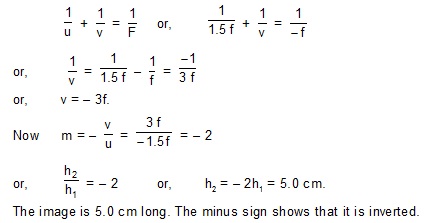
3. A printed page is kept pressed by a glass cube (µ = 1.5) of edge 6.0 cm. By what amount will the printed letters appear to be shifted when viewed from the top?
Sol. The thickness of the cube = t = 6.0 cm. The shift in the position of the printed letters is

4. The critical angle for water is 48.2°. Find its refractive index.
Sol. ![]()
5. The angle of minimum deviation from a prism is 37°. If the angle of prism is 53°, find the refractive index of the material of the prism.
Sol. 
6. Locate the image of the point object O in the situation shown in figure. The point C denotes the centre of curvature of the separating surface.
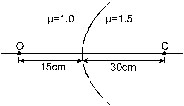
Sol. 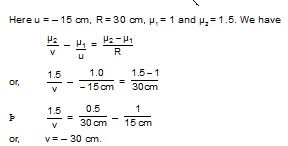
The image is formed 30 cm left to the spherical surface and is virtual.
7. Find the size of the image formed in the situation shown in figure.
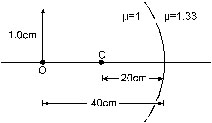
Sol. 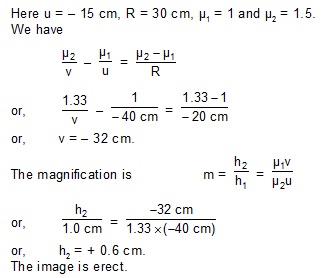
8. A biconvex lens has radii of curvature 20 cm each. If the refractive index of the material of the lens is 1.5, what is its focal length ?
Sol. In a biconvex lens, centre of curvature of the first surface is on the positive side of the lens and that of the second surface is on the negative side. Thus, R1 = 20 cm and R2 = – 20 cm.
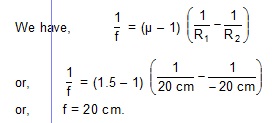
9. An object of length 2.0 cm is placed perpendicular to the principal axis of a convex lens of focal length 12 cm. Find the size of the image if the object is at a distance of 8.0 cm from the lens.
Sol. We have u = – 8.0 cm,. and f = + 12 cm
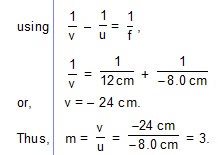
Thus, h2 = 3 h1 = 3 × 2.0 cm = 6.0 cm. The positive sign shows that the image is erect.
1. Is the formula “Real depth/Apparent depth = µ” valid if viewed form a position quite away from the normal?
2. Can you ever have a situation in which a light ray goes undeviated through a prism?
3. why does a diamond shine more than a glass piece cut to the same shape?
4. A narrow beam of light passes through a slab obliquely and is then received by an eye (figure). The index of refraction of the material in the slab fluctuates slowly with time. How will it appear to the eye? The twinkling of stars has a similar explanation.
5. Can a lane mirror even form a real image?
6. If a piece of paper is placed at the position of a virtual image of a strong light source, will the paper burn after sufficient time? What happens if the image is real? What happens if the image is real but the source is virtual?
7. Can a virtual image be photographed by a camera?
8. In motor vehicles, a convex mirror is attached near the driver’s seat to give him the view of the traffic behind. What is the special function of this convex mirror which a plane mirror can not do?
9. If an object far away from a convex mirror moves towards the mirror, the image also moves. does it move faster, slower or at the same speed as compared to the object?
10. Suppose you are inside the water in a swimming pool near an edge. A friend is standing on the edge. Do you find your friend taller or shorter than his usual height?
11. The equation of refraction at a spherical surface is
for refraction at a plane surface.
12. A thin converging lens is formed with one surface convex and the other plane. Does the position of image depend on whether the convex surface or the plane surface faces the object?
13. A single lens is mounted in a tube. A parallel beam enters the tube and emerges out of the tube as a divergent beam. Can you say with certainty that there is a diverging lens in the tube?
14. An air bubble is formed inside water. Does it act as a converging lens or a diverging lens?
15. Two converging lenses of unequal focal lengths can be used to reduce the aperture of a parallel beam of light without losing the energy of the light. This increases the intensity. Describe how the converging lenses should be placed to do this.
16. If a spherical mirror is dipped in water, does its focal length change?
17. If a thin lens is dipped in water, does it focal length change?
18. Can mirrors give rise to chromatic aberration?
19. A laser light is focused by a converging lens. will there be a significant chromatic aberration?
1. A point source of light is placed in front of a plane mirror.
(A*) All the reflected rays meet at a point when produced backward.
(B) only the reflected rays close to the normal meet at a point when produced backward
(C) only the reflected rays making a small angle with the mirror, meet at a point when
produced backward
(D) light of different colours make different images
2. Total internal reflection can take place only if
(A) light goes from optically denser medium refractive index) to optically denser medium
(B*) light goes from optically denser medium to rarer medium
(C) the refractive indices of the two media are close to each other
(D) the refractive indices of the two media are widely different
3. In image formation from spherical mirrors, only paraxial rays are considered because they
(A) are easy to handle geometrically
(B) contain most of the intensity of the incident light
(C*) show minimum dispersion effect.
(D) show minimum dispersion effect
4. A point object is placed at a distance of 30 cm from a convex mirror of focal length 30 cm. The image will form at
(A) infinity (B) pole
(C) focus (D*) 15 cm behind the mirror
5. Figure shows two rays A and B being reflected by a mirror and going as A¢ and B¢. The mirror -
(A*) is plane (B) is convex
(C) is concave (D) may be any spherical mirror
6. The image formed by a concave mirror
(A) is always real (B) is always virtual
(C*) is certainly real if the object is virtual (D) is certainly virtual if the object is real
7. Figure shows three transparent media of refractive indices µ1, µ2 and µ3. A point object O is placed in the medium µ2. If the entire medium on the right of the spherical surface has refractive index µ1. the image forms at O". If this entire medium has refractive index µ3, the image forms at O". In the situation shown,
.JPG)
(A) the image forms between O' and O"
(B) the image forms to the left of O'
(C) the image forms to the right of O''
(D*) two images form, one at O' and the other at O''
8. Four modifications are suggested in the lens formula to include the effect of the thickness t of the lens. Which one is likely to be correct?

9. A double convex lens has two surfaces of equal radii R and refractive index µ = 1.5. We have,
(A) f = R/2 (B*) f = R (C) f = – R (D) f = 2R.
10. A point source of light is placed at a distance of 2 f from a converging lens of focal length f. The intensity on the other side of the lens is maximum at a distance
11. A parallel beam of light is incident on a converging lens parallel to its principal axis. As one moves away from the lens on the other side on its principal axis, the intensity of light
(A) remains constant (B) continuously increases
(C) continuously decreases (D*) first increases then decreases
12. A symmetric double convex lens is cut in two equal parts by a plane perpendicular to the principal axis. If the power of the original lens was 4 D, the power of a cut lens will be -
(A*) 2 D (B) 3 D (C) 4 D (D) 5 D
13. A symmetric double convex lens is cut in two equal parts by a plane containing the principal axis. If the power of the original lens was 4D, the power of a divided lens will be -
(A) 2 D (B) 3 D (C*) 4 D (D) 5 D
14. Two concave lenses L1 and L2 are kept in contact with each other. If the space between the two lenses is filled with a material of refractive index µ » 1, the magnitude of the focal length of the combination
(A) becomes undefined (B) remains unchanged
(C*) increases (D) decreases
15. A thin lens is made with a material having refractive index µ = 1.5. Both the sides are convex. It is dipped in water (µ = 1.33). It will behave like
(A*) a convergent lens (B) a divergent lens
(C) a rectangular slab (D) a prism
16. A convex lens is made of a material having refractive index 1.2. Both the surfaces of the lens are convex. If it is dipped into water (µ = 1.33), it will behave like
(A) a convergent lens (B*) a divergent lens
(C) a rectangular slab (D) a prism
17. A point object O is placed on the principal axis of a convex lens of focal length f = 20 cm at a distance of 40 cm to the left of it. The diameter of the lens is 10 cm. An eye is placed 60 cm to right of the lens and a distance h below the principal axis. the maximum value of h to see the image is
(A) 0 (B*) 2.5 cm (C) 5 cm (D) 10 cm
18. The rays of different colours fail to converge at a point after going through a converging lens. This defect is called -
(A) spherical aberration (B) distortion
(C) coma (D*) chromatic aberration
1. If the light moving in a straight line bends by a small but fixed angle, it may be a case of
(A*) reflection (B*) refraction (C) diffraction (D) dispersion
2. Mark the correct option
(A) if the incident rays are converging, we have a real object
(B*) if the final rays are converging, we have a real image
(C) the image is virtual, the corresponding object a virtual object
(D) if the image is virtual, the corresponding object is called a virtual object.
3. Which of the following (referred to a spherical mirror) do (does) not depend on whether the rays are paraxial or not ?
(A*) pole (B*) focus (C*) radius of curvature (D) principal axis
4. The image of an extended object, placed perpendicular to the principal axis of a mirror, will be erect if
(A) the object and the image are both real (B) the object and the image are both virtual
(C*) the object is real but the image is virtual (D*) the object is virtual but the image is real
5. A convex lens forms a real image of a point object placed on its principal axis. If the upper half of the lens is painted black,
(A) the image will be shifted downward (B) the image will be shifted upward
(C*) the image will not be shifted (D*) the intensity of the image will decrease
6. Consider three converging lenses L1, L2 and L3 having identical geometrical construction. The index of refraction of L1 and L2 are µ1 and µ2 respectively. The upper half of the lens L3 has a refractive index µ1 and the lower half has µ2 (figure). A point object O is imaged at O1 by the lens L1 and at O2 by the lens L2 placed in same position. If L3 is placed at the same place,
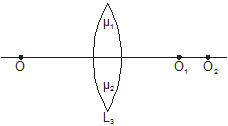
(A*) there will be an image at O1 (B*) there will be an image at O2
(C) the only image will form somewhere between O1 and O2
(D) the only image will form away from O2
